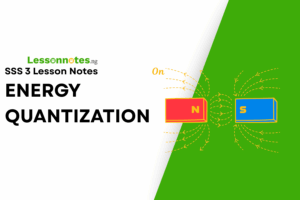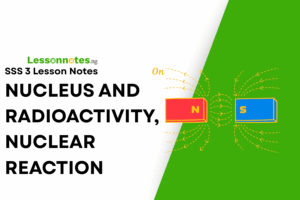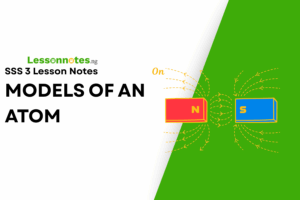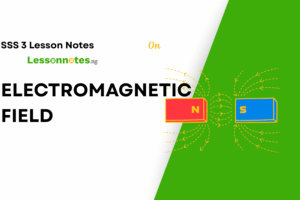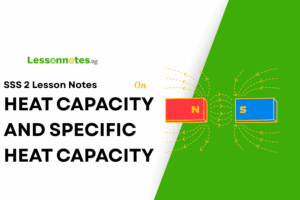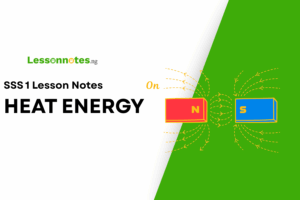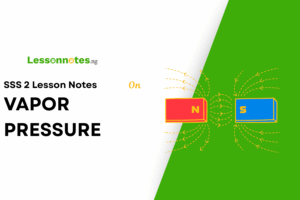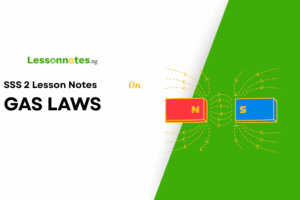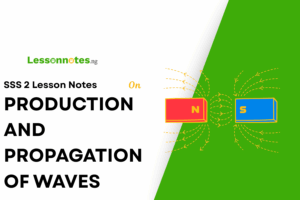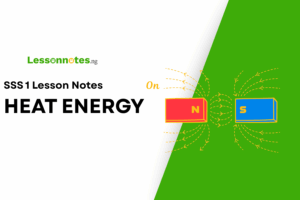Electromagnetic Induction SS3 Physics Lesson Note
Download Lesson NoteTopic: Electromagnetic Induction
Content
- Induced current
- Laws of Electromagnetic induction
- Induction Coil
- A/C and DC Generator
- Transformer and Power Transmission
Electromagnetic induction is the production of electric current or voltage in a conductor whenever there is a relative motion between the conductor and a magnetic field or a magnet.
The induced e.m.f. or current depends on
- the speed of motion of the magnet. The faster the speed of motion, the larger the induced current
- the number of turns of the coil
- the presence of a soft-iron core inside the coil
The direction of the induced current reverses when the direction of motion of the magnet or coil is reversed.
The coils A and C are wound on a steel ring R. When the switch S is closed, a deflection will be obtained on the galvanometer G, and when S is open G will show a deflection in the opposite direction.
Current will flow in the galvanometer whenever there is relative motion between the coil and the magnet. There is such a relative motion when the magnet moves towards the coil or away from the coil and when the magnet is stationary but the coil is moved. Such a current is called an induced current and the phenomenon is called electromagnetic induction.
EVALUATION
- Explain the term electromagnetic induction.
- Describe how induced currents are produced.
Law of Electromagnetic Induction.
There are two laws of electromagnetic induction
- Faraday’s law
- Lenz’s law
Faraday’s law of electromagnetic induction states that whenever a change in the magnetic lines of force (e.m.f) is induced, the strength of which is proportional to the rate of change of the flux linked with the circuit.
The magnetic flux or field lines linking a coil depends on
- the magnetic field strength
- the number of turns of the coil
- the area of each turn
To obtain a large induced e.m.f. move at a high speed across a strong magnetic field. Faraday’s law gives the magnitude of the induced e.m.f.
Lenz’s law of electromagnetic induction states that the induced e.m.f is in such a direction as two oppose the motion or change producing it.
Lenz law gives the direction of the induced e.m.f or induced currents.
EVALUATION
- State Faraday’s law of electromagnetic induction
- State Lenz law
- What are the benefits of these laws to modern-day engineering/
Induction Coil
This is an electrical device that is capable of producing a very high intermittent e.m.f .by electromagnetic induction from a low voltage d.c. Source e.g battery
It consists of:
- a primary coil, made up of a few turns of thick copper wire, wound on a laminated soft iron core. The lamination of the core is to reduce the loss of energy due to eddy currents.
- The secondary coil overlaps the primary coil. It is made up of a large number of turns of insulated thin copper wire. The ends of this coil are connected to an adjustable spark gap created by two adjustable brass rods.
- In front of the soft iron core of the primary coil is a make-and-break device consisting of a soft iron armature carried on a light brass spring to which is attached a platinum contact with an adjustable screw. The primary circuit is completed from this contact through a key and the battery which provides the current. The induction coil is commonly used in motor car ignition systems and in the operation of x-ray tubes.
EVALUATION
- Draw a labelled diagram of the induction coil
- Describe the principle of operation of the induction coil.
A.C and D.C Generator.
A machine that converts mechanical energy into electrical energy or electrical energy into mechanical energy is called a dynamo. When it changes mechanical energy into electrical energy it is called a generator, but when it changes electrical energy into mechanical energy, it is called a motor.
There are two classes of generators, the alternating current (A.C) generator and the direct current (D.C) generator.
The A.C. generator consists of:
- An armature a rectangular coil consisting of a large number of turns of insulated wire. wound on a laminated soft iron core.
- a magnetic field created by the curved poles of a horse-shoe magnet or an electromagnet.
- two copper slip rings to which the ends of the rectangular coil are connected and which rotate with the armature.
- two stationary carbon brushes which are made to press lightly against the slip rings
EVALUATION
- Draw a labelled diagram of the A.C generator
- Describe the principle of operation of the A.C generator.
Direct Current ( D.C) Generator
An a.c. generator can be made to produce a d.c by replacing the two slip rings with a single split ring or commutator. A split ring commutator is a slip ring that has been split into two segments which are insulated from each other. The ends of the coil are connected one to each split ring or commutator segment.
The commutator is a current reverser. When the armature coil is rotated, the commutator automatically switches each end of the coil from one brush to the other each time the coil completes one-half of a revolution. As the current reverses in the coil after each half revolution, the connection between the coil and the brushes is reversed through the action of the commutator.
Transformer and Power Transmission
A transformer is an electrical device for changing the size of an a.c. voltage. It acts to increase or decrease the emf of an alternating current. It consists of two separate sets of coils, the primary coil and the secondary coil. The primary coil is the input winding of turns of wire and the secondary coil is the output winding. The coils are wound around a soft-iron core. The soft-iron core acts to increase and concentrate the magnetic flux within the core. It is also laminated, i.e. it consists of sheets of soft-iron insulated from each other instead of a solid block of iron. This lamination reduces the loss of energy in the form of heat due to eddy currents introduced in the core.
Step down transformer
When an alternating e.m.f. or a.c voltage (EP) is applied at the terminals of the primary coil (p), an alternating magnetic flux is produced in the iron core which links or threads the secondary coil (s). An alternating emf (Es) of the same frequency as that Ep is induced in the secondary coil by mutual inductance.
Mutual inductance is the flow of induced current or voltage in a coil due to an alternating or varying current in a neighbouring coil.
The total flux linking the two coils is proportional to their number of turns. The induced e.m.f in the secondary coil (Ep) depends on the e.m.f. in the primary coil and on the ratio of the number of turns in each
:. ES=Ns
Ep Np
In an ideal transformer with a 100% efficiency, the power developed in the secondary coil is equal to the power developed in the primary coil.
To use a transformer to increase an applied voltage, i.e to make Es greater than Ep, Ns must be greater than Np, such a transformer which increases or steps up the applied or primary voltage is called a step-up transformer. In a step-up, the primary current is greater than the secondary current but the primary voltage is less than the secondary voltage.
Energy Losses in Practical Transformer
There are energy losses in practical transformers due to:
- Eddy currents
- Hysteresis loss
- iii. Heat loss
- Leakage of magnetic flux
Eddy Current reduces efficiency because they consume power and this causes energy lost in the form of heat. Such loss can be reduced by laminating the core.
Hysteresis loss is wasted energy due to reversing the magnetization of the core. It is reduced by the use of special alloys in the core of the primary coil.
Heat loss: the primary and secondary coils have resistance, some energy is lost in the form of heat(I2R) in the coils. This can be reduced by using thick wires or low-resistance coils.
Some energy is lost due to leakage of magnetic flux. This arises because not all the lines of induction due to current in the primary coil pass entirely through the iron core. This loss is reduced by efficient core design.
Example
- Find the turns ratio in a transformer which delivers a voltage of 12ov in the secondary coil from a primary voltage of 60v.
- A transformer has 500 turns in the primary coil and 300 turns in the secondary coil. If the primary coil is connected to 220v mains, what voltage will be obtained from the secondary coil? What type of transformer is this?
- A transformer supplies 15v from a 220v mains. If the transformer takes 0.7A from the mains when used to light three lamps connected in parallel each rated 15v,40w, calculate:
- the efficiency of the transformer
- the cost of using it for 24hrs at 30k per kwh.
EVALUATION
- Draw a labelled diagram to explain the working of a transformer which can produce 24v from a 240v supply.
- Give two reasons which explain why the efficiency of the transformer cannot be 100%.
POWER TRANSMISSION
Power generated at power stations is distributed over large distances to consumers through metal cables, Power can be transmitted either at low current and high voltage or at high current and low voltage. Because the metal cables through \h which the power is transmitted have a certain amount of electrical resistance, transmitting power at high current will lead to loss of energy in the form of heat. To avoid this, this power is transmitted at high voltage and low current. This is known as high-tension transmission.
Low currents lead to low energy loss. It also requires thinner cables and the cost of cable materials is considerably reduced if power is transmitted with low current and high voltages.
Step-down transformers are used to reduce the high transmitted voltages to lower voltages required in homes and factories.
Reading Assignment
- New School Physics pg 447 457
WEEKEND ASSIGNMENT
- Induced current depends on the
- number of turns in the coil
- strength of the magnet
- the speed with which the magnet is plunged into the coil
Which of these is/are false
(a) I only (b) II only (c) II and III only (d) III only (e) None of the above.
- To convert an alternating current dynamo into a direct current dynamo the ;
(a) number of turns in the coil is increased (b) strength of the field magnet is increased (c) slip rings are replaced with split rings commutator (d ) coil is wound on a soft iron armature
- Which of the following devices would be used on its own in the working of a petrol-driven motor car engine for obtaining a high voltage from a low one (a) induction coil (b) A.C dynamo (c ) D.C generator (d) the transformer (e) the electric motor.
- A transformer with 5500 turns in its primary is used between a 240v a.c supply and a 120v kettle. Calculate the number of turns in the secondary (a) 1100 (b) 2750 (c ) 460 (d) 232 (e) 10.
- If a current carrying� coil is mounted on a metal frame, the back e.m.f. induced in the coil causes (a) inductance (b) Eddy current s(c) Electromagnetism (d) Dipole moment.
Theory
- With the aid of a diagram, describe the principle of an induction coil. Mention two applications of this device.
1b. State the laws of electromagnetic induction
- Distinguish between a step-up and a step-down transformer.
- Give two reasons why it is preferred to transmit power over long distances using a high voltage and a low current.


